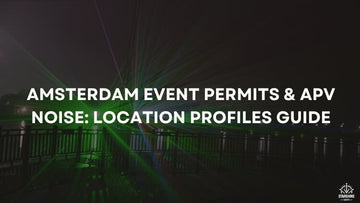Running a laser light show in Amsterdam isn’t just watts and lenses. It’s paperwork, neighbors, and timing. This field-tested guide puts the Evenementenvergunning (event permit), APV noise practice, and the city’s evolving 2025 location profiles into plain choices you can act on—load-in, content, and gear spec. It’s written for rental houses and distributors who buy in batch, request OEM/ODM tweaks, and live under real SLA clocks.

1) “Notification” vs “Permit”: pick the path early
Very small, low-impact activities can sometimes be handled via a simple notification. Most true events—amplified sound, temporary structures, crowd control—need a full Evenementenvergunning (paid application). Larger headcounts (e.g., >2,000) push lead time and documentation. Match your scope to city guidance and the relevant location profile.
- Site layout (access, egress, emergency routes, barriers)
- Geluidsplan (measurement chain, façade monitoring, A/C targets, ownership)
- Crowd & traffic plan, power single-line, build/strike schedule
- Sustainability & nuisance mitigation (mains first, generator runtime, neighbor comms)
- Indoor or “temporary change of use”? Run an Omgevingsloket check

Permit timeline snapshot (T-10 → +48h)
- T-8–10 weeks — Decide notification vs Evenementenvergunning. Lock scope: headcount, amplified sound, temporary structures.
- T-7–8 weeks — Draft site layout + Geluidsplan (monitor points, responsibilities, method, low-freq policy).
- T-6 weeks — Crowd/traffic/power/egress; sustainability & nuisance notes; Omgevingsloket check if changing use.
- T-4 weeks — Submit the pack; align schedule with the location profile (visitor cap, A/C framing, build/strike windows).
- T-2 weeks — Neighbor letter & hotline; quiet hours; book third-party measurement if required.
- Show week — Onsite check, façade monitors, IP65 laser light cabling & aiming logs.
- +48h — Upload measurement summary + incident notes (keeps your organizer profile “green”).

2) APV noise in real life: 70 dB(A) vs dB(C)
Many teams were trained on “70 dB(A) at the façade” for small events. Current practice often adds a dB(C) limit to control low-frequency (numbers like 85 dB(C) appear). Your actual limits are set in your permit and the site’s location profile. Don’t assume—attach the official letter to your show pack.
- Geluidsplan basics: measurement chain, façade monitors, day/evening/night A & C targets, action thresholds, who holds the faders.
- Content choices: on residential edges, trim subs; use beam-forward looks. A professional laser show with high contrast reads better than brute bass.
- Monitoring & comms: add a hot-façade point, publish a hotline, and log responses. Calm neighbors beat any limiter.
Geluidsplan: the 8 essentials
- Measurement chain (model, calibration, date)
- Monitoring points (façade map + coordinates)
- A & C targets by time window (with action thresholds)
- System ownership (name/phone of fader owner)
- Directionality & aiming (arrays, beam-forward content, indoor/outdoor tactics)
- Complaint workflow (hotline, log format, response times)
- Dependencies (wind, haze, water/glass reflections)
- Post-event report template (LAeq/LCeq per window, incidents, actions)

3) 2025 policy: location profiles drive the calendar
Amsterdam’s new policy tries to balance resident peace with a lively event mix. Location profiles define visitor caps, annual quotas, noise framing (A/C), and build/strike windows. That one page sets runtime and cost. Treat it like a spec.
- Visitor cap — staff & barriers scale from here.
- Annual quota — how many events the site hosts.
- Noise framing — A & C goals by daytime/evening/night; sometimes “no flown subs”.
- Build/strike windows — curfews that hit trucking & overtime.
- Sustainability asks — mains first, generator limits, transport plans.
4) Site & content strategy: residential / parks / water / indoor
Control C-weight; push high-contrast laser looks; end earlier; monitor the most complaint-prone façade; publish a hotline.
Use micro-wind tactics: low wind breaks, distributed haze, directional arrays. Document sustainability in the pack.
Reflections boost brightness (and glare). Use IP65 laser light rigs with drip loops & weather boots; add waterside power & anti-fall notes to the permit bundle.
Camera-friendly beams with micro-dose haze; think TV: tighter angles, higher contrast, less glare.
5) Starshine field notes
Case A — Community Mini-Festival (residential edge)
Scope grew from notification to permit. The Geluidsplan plus a “low-LF” content preset passed without revisions; complaints: zero.
Case B — Waterfront Pop-Up (park × canal)
We aligned to the location profile and added water-safety notes. Distributed haze with wind breaks kept beams “camera-clean” without cranking levels on the laser light projector outdoor rig.
Case C — Multi-site Weekend (autumn)
Two variants: Full and Low-C. Batch shipping of IP65 racks with OEM/ODM I/O and label packs, plus factory FAT photos, helped the client clear a multi-site tender in one round.
6) Delivery & tendering: docs, OEM/ODM, SLA
- Document bundle — layout, Geluidsplan, traffic/power/build-strike/egress, sustainability & nuisance notes (template once, reuse in batch).
- Compliance pack — EN/IEC 60825-1 labels/manuals; audience-safe alternatives; aviation awareness; indoor “temporary use” checks via Omgevingsloket.
- OEM/ODM — location-driven I/O (True1/powerCON), breather vents, rain caps, flight cases; manufacturer FAT photos per lot.
- SLA & spares — 24/48/72h tiers; 2–5% spares; seasonal O-ring & desiccant kits.
- Control ecosystems — run DMX laser busking and FB4/BEYOND for timecode; many shows switch per scene.
Frequently Asked Questions
When is a notification enough—and when do I need a full permit?
Is it 70 dB(A) or 85 dB(C)?
What technical documents must I attach?
How do location profiles affect schedule and budget?
Do you support batch/OEM/ODM and tender docs?
How do we keep a “camera-clean” laser look at lower levels?
Do we need FB4 or just DMX?
Can we share the Geluidsplan with neighbors?
Take the Next Step
- Get the Location-Profile Readiness Checklist
- Download the Geluidsplan Template (editable)
- Ask for the KNMI-ready quoting sheet (weather notes + power & haze presets)
About the Author
Mark (Starshine Project Manager) — 9+ years in Benelux outdoor show control and permitting. Specialized in moving head laser light design, show laser projector integration, and neighbor-friendly APV compliance.



























